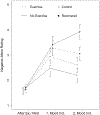Acute exercise attenuates negative affect following repeated sad mood inductions in persons who have recovered from depression
- PMID: 22985013
- PMCID: PMC11877280
- DOI: 10.1037/a0029881
Acute exercise attenuates negative affect following repeated sad mood inductions in persons who have recovered from depression
Abstract
Identifying factors that may protect individuals from developing Major Depressive Disorder (MDD) in the face of stress is critical. In the current study we experimentally tested whether such a potentially protective factor, engaging in acute exercise, reduces the adverse effects of repeated sad mood inductions in individuals who have recovered from depression. We hypothesized that recovered depressed participants who engage in acute exercise report a smaller increase in negative affect (NA) and a smaller decrease in positive affect (PA) when exposed to a repeated sad mood induction (i.e., habituation), whereas participants who do not exercise show sensitization (i.e., increased NA and decreased PA in response to a repeated adverse stimulus). Forty-one women recovered from MDD and 40 healthy control women were randomly assigned to either exercise for 15 minutes or quiet rest. Afterward, participants were exposed to two sad mood inductions and reported their levels of affect throughout the study. Recovered depressed participants who had not exercised exhibited higher NA after the second sad mood induction, a finding consistent with sensitization. In contrast, both recovered depressed participants who had engaged in acute exercise and healthy control participants showed no increase in NA in response to the repeated sad mood induction. Participants who exercised reported higher PA after the exercise bout; however, our hypothesis concerning reported PA trajectories following the sad mood inductions was not supported. Results suggest that exercise can serve as a protective factor in the face of exposure to repeated emotional stressors, particularly concerning NA in individuals who have recovered from depression.
2013 APA, all rights reserved
Figures

Similar articles
-
The measurement of cognitive reactivity to sad mood in patients remitted from major depressive disorder.Br J Clin Psychol. 2018 Sep;57(3):313-327. doi: 10.1111/bjc.12175. Epub 2018 Feb 27. Br J Clin Psychol. 2018. PMID: 29488231 Free PMC article.
-
Further evidence of emotional allodynia in unmedicated young adults with major depressive disorder.PLoS One. 2013 Nov 28;8(11):e80507. doi: 10.1371/journal.pone.0080507. eCollection 2013. PLoS One. 2013. PMID: 24312229 Free PMC article.
-
Attentional biases and the persistence of sad mood in major depressive disorder.J Abnorm Psychol. 2013 Feb;122(1):74-85. doi: 10.1037/a0029211. Epub 2012 Aug 6. J Abnorm Psychol. 2013. PMID: 22867117 Free PMC article.
-
Influence of Exercise Intensity for Improving Depressed Mood in Depression: A Dose-Response Study.Behav Ther. 2016 Jul;47(4):527-37. doi: 10.1016/j.beth.2016.04.003. Epub 2016 Apr 27. Behav Ther. 2016. PMID: 27423168 Clinical Trial.
-
Effects of acute exercise on mood and well-being in patients with major depressive disorder.Med Sci Sports Exerc. 2005 Dec;37(12):2032-7. doi: 10.1249/01.mss.0000178101.78322.dd. Med Sci Sports Exerc. 2005. PMID: 16331126 Clinical Trial.
Cited by
-
Personalized metabolomics for predicting glucose tolerance changes in sedentary women after high-intensity interval training.Sci Rep. 2014 Aug 28;4:6166. doi: 10.1038/srep06166. Sci Rep. 2014. PMID: 25164777 Free PMC article.
-
A Mixed-Method Assessment of a 10-Day Mobile Mindfulness Intervention.Front Psychol. 2021 Aug 31;12:722995. doi: 10.3389/fpsyg.2021.722995. eCollection 2021. Front Psychol. 2021. PMID: 34531801 Free PMC article.
-
Effects of aerobic exercise on sad emotion regulation in young women: an electroencephalograph study.Cogn Neurodyn. 2019 Feb;13(1):33-43. doi: 10.1007/s11571-018-9511-3. Epub 2018 Nov 11. Cogn Neurodyn. 2019. PMID: 30728869 Free PMC article.
-
Interactions between Cognitive, Affective, and Respiratory Profiles in Chronic Respiratory Disorders: A Cluster Analysis Approach.Diagnostics (Basel). 2024 May 30;14(11):1153. doi: 10.3390/diagnostics14111153. Diagnostics (Basel). 2024. PMID: 38893678 Free PMC article.
-
Physical activity and negative affective reactivity in daily life.Health Psychol. 2017 Dec;36(12):1186-1194. doi: 10.1037/hea0000532. Epub 2017 Oct 9. Health Psychol. 2017. PMID: 29016149 Free PMC article.
References
-
- Almeida DM (2005). Resilience and vulnerability to daily stressors assessed via diary methods. Current Directions in Psychological Science, 14, 64–68.
-
- Babyak M, Blumenthal JA, Herman S, Khatri P, Doraiswamy M, Moore K, … Krishnan KR (2000). Exercise treatment for Major Depression: Maintenance of therapeutic benefit at 10 months. Psychosomatic Medicine, 62, 633–638. - PubMed
-
- Beck AT, Steer RA, & Brown GK (1996). Manual for the Beck Depression Inventory-II. San Antonio, TX: Psychological Corporation.
-
- Blumenthal JA, Emery CF, Walsh MA, Cox DR, Kuhn CM, Williams RB, & Sanders Williams R (1988). Exercise training in healthy Type A middle-aged men: Effects on behavioral and cardiovascular responses. Psychosomatic Medicine, 50, 418–433. - PubMed
Publication types
MeSH terms
Grants and funding
LinkOut - more resources
Full Text Sources
Other Literature Sources
Medical

